Keith Haring’s collaboration with Playboy Magazine – “The Playboy Suite”
At the digital marketing consultancy Journey, we’re passionate about art. In this blog post, we’ll cover one of the world’s greatest artists – Keith Haring – and his collaboration with Playboy Magazine, affectionately dubbed “The Playboy Suite”.
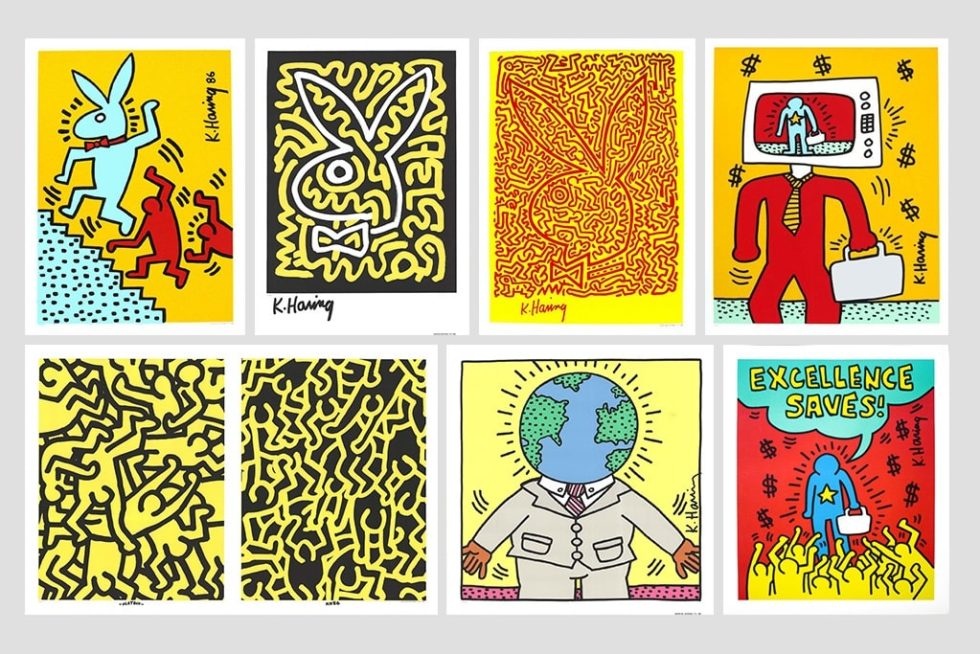
Guy Hepner gallery writes about Keith Haring:
“Bridging the gap between the art world and the street, Keith Haring rose to prominence in the early 1980s with his graffiti drawings made in the subways and on the sidewalks of New York City. Combining the appeal of cartoons with the raw energy of Art Brut artists like Jean DuBuffet, Haring developed a distinct pop-graffiti aesthetic centered on fluid, bold outlines against a dense, rhythmic overspread of imagery like that of babies, barking dogs, flying saucers, hearts, and Mickey Mouse. In his subway drawings and murals, Haring explored themes of exploitation, subjugation, drug abuse, and rising fears of nuclear holocaust, which became increasingly apocalyptic after his AIDS diagnosis. Alongside Jean-Michel Basquiat, Kenny Scharf, and Jenny Holzer, Haring is regarded as a leading figure in New York East Village Art scene in the 1970s and ’80s.”
Haring died February 16 1990, more than a year after being diagnosed as having the AIDS virus. Prior to his death he had been active in many political and social causes, including ones related to AIDS.
In 1986, Playboy commissioned Haring to produce several works for their magazine. After Haring died in 1990, Playboy reproduced several of these pieces in limited editions and merchandise – through their subsidiary Special Editions, Ltd. in Chicago, IL. The works are sometimes individually or collectively referred to as the “KH86 suite”. Although the collaboration initially was a success, it was a later source of controversy, as the Keith Haring Foundation claimed the magazine sold the designs as merchandise without obtaining an extension of the rights.
On 1st of June 1990, the Chicago Tribune ran an article on the debacle:
“Bunny No. 1” and “Bunny No. 2” never made the pages of Playboy magazine, but the 1986 drawings by the late pop artist Keith Haring are at the center of a federal suit filed against Playboy Enterprises Inc. by Haring’s estate.
Lawyers for the estate of Haring, who died in February at age 32, sued Playboy and what they said were affiliated companies, charging unauthorized sale and distribution of a series of limited-edition reproductions of works by Haring.
Haring’s work was characterized by cartoon-like human and animal figures. His distinctive drawings on subway station walls first caught the eye of art dealers about 10 years ago. He was best known for murals in public places, including a 300-foot-long mural he painted on the Berlin Wall in 1986.
Also in 1986, he created the “Bunny No. 1” and “Bunny No. 2” drawings. The suit said he granted Playboy the right to publish “Bunny No. 2” on the January 1987 cover of the magazine, for which Playboy agreed to pay $5,000 regardless of whether the drawing was used.
According to the suit, filed in U.S. District Court in New York Wednesday, Haring didn’t assign any other rights to either drawing to Playboy. The suit seeks to enjoin distribution of the reproductions as well as unspecified damages.
Terri Tomcisin, a Playboy spokeswoman, said the company hadn’t received a copy of the suit and couldn’t comment on it.
However, she said Playboy had commissioned Haring, paid for and clearly owns the rights to three rabbit-head drawings intended for covers that were never published and another drawing called “Earthman”, which ran inside the magazine in the January 1986 issue.
She said the reproductions are now being sold as posters, limited to a total of 1,000 each for the four drawings. However, Tomcisin said the posters aren’t numbered, and no claim is made that Haring signed the reproductions individually. She said the suggested retail price is $225 each.
In the suit, the estate claims the defendants “have engaged in false representations calculated to deceive consumers into falsely believing that their reproductions of the works are valuable limited-edition art works made by and under the direction and control of Haring.”
Special Editions Ltd., another defendant, is a subsidiary of Playboy formed in 1988 to market its extensive art collection. For example, it received $2.1 million from the sale of 161 paintings by LeRoy Neiman.
In joint ventures, the company has released limited-edition prints and posters of works by Andy Warhol, Alberto Vargas, Robert Hoppe and Dennis Mukai that ranged in price from $300 to $750.
Julia Gruen, an estate administrator and executive director of the Keith Haring Foundation, which is the primary beneficiary, said that “regrettably, Playboy has apparently decided to capitalize on the market activity which has resulted from Mr. Haring`s illness and untimely death.”
On August 9th 1990, the estate of the late artist settled the suit it brought against Playboy Enterprises Ltd. charging Playboy with reproducing and selling Haring`s “bunny” drawings without approval. Under the settlement, Playboy agreed to recall and cease marketing reproductions of two of four images. The estate agreed not to dispute Playboy’s right to market reproductions of the other two images, subject to specific disclaimers and limitations.
However, that was not the end of the story, as on February 4th 1992, the Keith Haring estate sued Playboy again:
The estate of the late pop artist Keith Haring sued Playboy Enterprises Inc. Monday, alleging breach of contract in the creative “dismemberment” of his work in its marketing and merchandising.
A federal court suit filed in New York City stems from the 1990 settlement of a previous lawsuit between the estate and Playboy. That litigation, involving the alleged unapproved reproduction and sale of Haring “bunny” drawings done for Playboy magazine, resulted in Playboy ceasing to market two of four images.
At issue now in the suit, which alleges that the estate is owed at least $1 million in damages, is “Dancers”, one of the original four works. It was a six-sided, perforated pullout in the December 1986 issue of Playboy.
The estate claims that Playboy has illegally “chopped up” the work into six pieces, given each a name and sold each separately as merchandise, including reproducing the images on wristwatches, according to New York attorney Franklin Bonem.
Playboy spokeswoman Terri Tomcisin said Monday that the estate “seems to be more interested in publicity than in the truth, since this is the second time they’ve attacked us for publishing works that we own.
“We don’t know what their problem is, as the estate has already acknowledged that we own the copyrights to “Dancers”. We believe the claims asserted by the estate are without merit and we are confident that Playboy’s position will be completely vindicated by the time the case has been fully heard”.
On the internet today, there is very little information on the various pieces Keith Haring did for Playboy Magazine. As such, we decided to do some digging to try to establish what prints, posters and merchandise belongs to the partly unauthorized Keith Haring “Playboy Suite”.
The news stories above speak of several different images, including “three rabbit-head drawings”:
- Bunny I, or Bunny No. 1 (created 1986, printed 1990)
- Bunny II, or Bunny No. 2 (created 1986, printed 1990)
- Bunny III, or Bunny No. 3 (created 1986, printed 1990), all of which were “intended for covers that were never published”.
- Earth-Man (1986), which “ran inside the magazine in the January 1986 issue”.
It is said in the first article that these prints, or posters, were all printed by Special Editions Ltd. in an edition size of 1000 each, with a suggested retail price of $225.
In the second article above, another poster or print is also mentioned:
- Dancers (created 1986)
The estate claims that Playboy has illegally “chopped up” this work into six pieces, given each a name and sold each separately as merchandise.
If you Google “Keith Haring Playboy”, you’ll only find lots of different posters and prints, all claiming to be commissioned by Playboy. But can we match any of them to the limited information above? Let’s see.
The Playboy Bunny posters
The news story speak of three different Bunny posters. Two of them are relatively easy to identify.
Playboy Bunny No. 1 (1990)
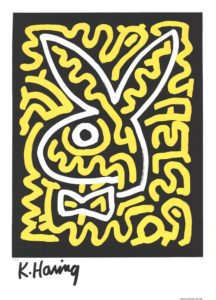
Playboy Bunny No. 1 by Keith Haring, created in 1986, printed in 1990. Unsigned serigraph (silkscreen). Paper size is 32 x 23 inches, with an image size of 25.75 x 20 inches. This is one of three rabbit-head drawings intended for covers that were never published.
Playboy Bunny No. 2 (1990)
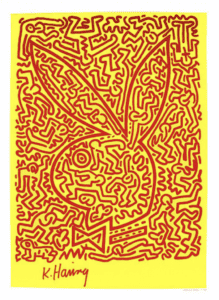
Playboy Bunny No. 2 by Keith Haring, created in 1986, printed in 1990. Unsigned serigraph (silkscreen). Paper size is 32 x 23 inches, with an image size of 25.75 x 20 inches. Haring granted Playboy the right to publish “Bunny No. 2” on the January 1987 cover of the magazine, for which Playboy agreed to pay $5,000 regardless of whether the drawing was used.
There is no evidence that the last Playboy bunny drawing – named Playboy Bunny No. 3 – was ever made into a poster or print. As far as we can tell, no images exist of this drawing on the internet today. [Editor’s note: If you have supplemental information to this article, please feel free to contact us]
As the rest of the Special Editions, Ltd. pieces, the Bunny posters features the brief explanation of the circumstances surrounding the editions on the reverse:
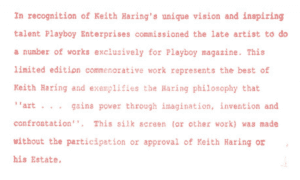
The stamp reads:
“In recognition of Keith Haring’s unique vision and inspiring talent Playboy Enterprises commissioned the late artist to do a number of works exclusively for Playboy Magazine. This limited edition commemorative work represents the best of Keith Haring and exemplifies the Haring philosophy that “art…gains power through imagination, invention and confrontation”. This silk screen (or other work) was made without the participation or approval of Keith Haring or his estate.”
An important note: In the case you come across a print from the Keith Haring Playboy Suite, you should enquire if the print has the stamp above on the back. If it does not have it, this is a strong indication that you are dealing with a later reproduction. Companies like King & McCaw put out great looking and decorative Keith Haring reproductions, but they’re not “Keith Haring lithograph originals” or part of the Playboy Suite per se.
The editorial pieces
The articles from 1990 and 1992 also speak about one or more editorial drawings, which ran inside the magazine in the January 1986 issue, and perhaps later issues.
Our research shows that there are probably four pieces in the series: Playboy 2 (dubbed “Bunny on the Run”, which was re-released in 1995 in a smaller, blue colorway named “Bunny on the Move”), Playboy 3 (dubbed “Excellence Saves”), Earthman, and Untitled (dubbed “TV Man”).
Playboy 2, dubbed “Bunny on the Run” (1990)

Playboy 2, dubbed “Bunny on the Run”, by Keith Haring, created in 1986, printed in 1990. Unsigned serigraph (silkscreen). Paper size is 23 x 32 inches / 58.5 x 81 cm. Edition size of 1000. Part of the editorial pieces
Playboy 3, dubbed “Excellence Saves” (1990)
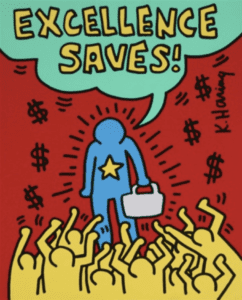
Playboy 3, dubbed “Excellence Saves”, by Keith Haring, created in 1986, printed in 1990. Serigraph (silkscreen). Paper Size is 30 x 36 inches. Edition size of 1000. This is the original red and yellow version, printed by Special Editions Ltd. in 1990.
Earthman (1990)

Earthman by Keith Haring, created in 1986, printed in 1990. Serigraph (silkscreen). Paper size is 26 x 26 inches, with an image size of 23.25 x 23.25 inches. Edition size of 1000.
TV Man (1990)

TV Man by Keith Haring, created in 1986, printed in 1990. Serigraph (silkscreen). Paper size is 32.1 x 26.3 in. Edition size of 1000.
The “chopped-up” and later pieces
The lawsuit also mentioned at least six “chopped-up” pieces. However, our research leads us to believe the number of such pieces are more than six.
In the December 1986 issue of Playboy Magazine two Haring hang-up christmas pieces are found: “Dancers” and a reversible hang-up decoration (“Inverted”).
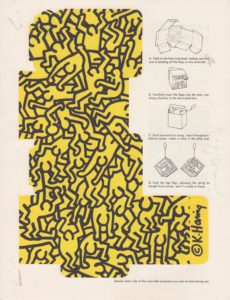
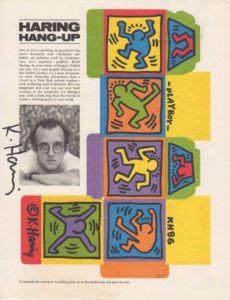
Source: Harper’s Books
The pieces measure 8 1/2 x 11 inches. The christmas ornaments can be assembled by punching out the design for the perforated page and then folding them into reversible cubes.
Our research indicates that Playboy Magazine reworked these illustrations to create several different editions and merchandise. According to the estate’s original complaint in 1992, Playboy took the folding, three-dimensional christmas ornament called “Dancers” (1986) and turned it into six plate signed works, which was since reproduced on watches and other merchandise.
In addition, they reworked the “Inverted” hang-up christmas decoration into Playboy 1, shown below:
Playboy 1 / Playboy I, dubbed “Inverted” (1990)

Playboy 1 / Playboy I, dubbed “Inverted”, sometimes individually referred to as “KH86”, by Keith Haring, created in 1986, printed in 1990. Serigraph (silkscreen). Paper size is 26 × 40 in / 66 × 101.6 cm. Edition size of 1000.“Dancers”, or “Dancing Man”, or “Six Dancing People” (1990)
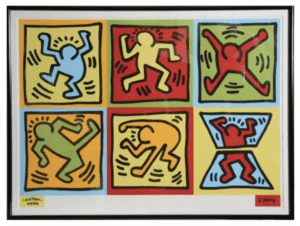
“Dancers”, or “Dancing Man”, or “Six Dancing People”, by Keith Haring, created in 1986, printed in 1990. Serigraph (silkscreen). Paper size is 36 x 28 in. (91.44 x 71.12 cm). Edition size of 1000. Not numbered, plate signed.
Six individual “Dancers” posters (1991)
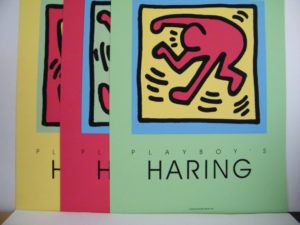
Six individual “Dancers”, or “Dancing Man”, or “Six Dancing People”, by Keith Haring, created in 1986, printed in 1990. Serigraph (silkscreen). Paper size is 18 x 24 in. Edition size of 1000 per poster. Not numbered, plate signed.
Bunny on the Move (1995)

Keith Haring’s Bunny on the Move is a re-release of Playboy 2, dubbed “Bunny on the Run”, from 1990. “Bunny on the Move” is a blue, smaller version. Paper size: 9 x 12 inches. Unknown edition, not numbered, plate signed. The bottom of the page reads:
“Ververke Gallery Edition / P.O.Box 67-6710 BB EDE / 14536 / Bunny on the Move by Keith Haring 1986 / 1995, Special Editions Limited: From the Playboy Art Archives / Produced by Verkerke, who has obtained the permission of Special Editions, Ltd. The copyright owner of the Keith Haring image shown without the participation of Keith Haring or his estate.”
Excellence Saves! Blue/Yellow colorway (1995)
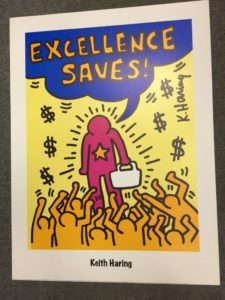
Keith Haring’s Excellence Saves! Blue/Yellow is a re-release of Playboy 3, dubbed “Excellence Saves”, from 1990. Excellence Saves! is a blue and yellow, slightly smaller version. Paper size is 23 5/8 x 31 1/2 inches. Image size is 19 5/8 x 25 7/8 inches. Unknown edition, not numbered, plate signed. The reproduction was printed in The Netherlands by Verkerke Gallery, with permission from The Playboy Art Archives.
Excellence Saves! Green/Blue colorway (1995)
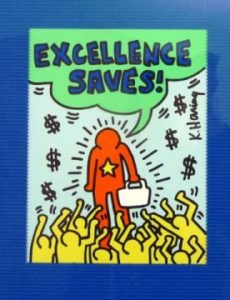
Keith Haring’s Excellence Saves! Green/Blue is a re-release of Playboy 3, dubbed “Excellence Saves”, from 1990. Excellence Saves! is a green and blue, slightly smaller version. Paper size is 23 5/8 x 31 1/2 inches. Image size is 19 5/8 x 25 7/8 inches. Unknown edition, not numbered, plate signed. The reproduction was printed in The Netherlands by Verkerke Gallery, with permission from The Playboy Art Archives.
[Editor’s note: If you have supplemental information to this article, please feel free to contact us]